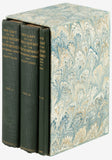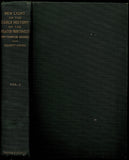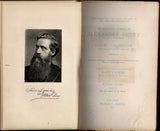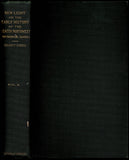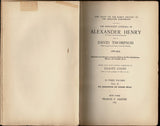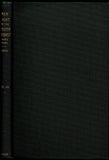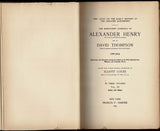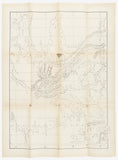New Light on the Early History of the Greater Northwest. The Manuscript Journals of Alexander Henry and David Thompson. 1799-1814
Author: Alexander Henry (1739-1824) and David Thompson
Year: 1897
Publisher: Francis P. Harper
Place: New York
Description:
3 volumes. xxviii+[1]-446 pages with frontispiece ; vi+[447]-916 pages; [vi]+ [917]-1027 pages with 3 folding maps and folded text sheet in rear pocket. Royal octavo (9¼" x 6") bound in original publisher's original green cloth, spines lettered in gilt, custom marbled paper-covered slipcase. Edited by Elliott Coues. No. 887 of 1100 copies. (Howes H419; Tweney 9.) First Edition.
Important source material on early trade and exploration in the far west. Tweney describes it as "an entirely new and original work printed from the original manuscripts, and contains the authors' daily journal of travels, explorations, and adventures in the fur trade throughout the Northwest."
Alexander Henry 'The Elder' was an American-born explorer, author, merchant who settled in Quebec following the Conquest of New France and was a partner in the North West Company and a founding member and vice-chairman of the Beaver Club. From 1763 to 1764, he lived and hunted with Wawatam of the Ojibwe, who had adopted him as a brother.
Henry's imagination was caught by the rich potential of the Northwest Territories and he sailed to England in the autumn of 1776 with a proposal for the Hudson's Bay Company. Bearing a Letter of introduction from Luc de la Corne to his brother Abbé Joseph-Marie de La Corne de Chaptes, Henry next went to France where he was met with "a most flattering reception". Henry returned to British North America in 1777 in partnership with Jean-Baptiste Blondeau andtaded at the Michipicoten River and Sault Ste Marie; all the time, he worked closely with his old friend Cadot. Between 1778 and 1781 he visited England three times and developed friendships with Sir Joseph Banks and Daniel Solander. Having discussed the possibility at Banks' residence on Soho Square with him and Solander, on his last trip to England, Henry delivered a detailed plan to Banks for an expedition to find an overland route to the Pacific Ocean.
In 1809, Henry had written to Askin, "There is only us four old friends (James McGill, Isaac Todd, Joseph Frobisher, and himself) alive, all the new North westards are a parcel of boys and upstarts, who were not born in our time, and supposes they know much more of the Indian trade than any before them." To recapture his exciting past, he wrote a memoir of his life which he published in New York that year and dedicated to his English friend, Sir Joseph Banks. Travels and Adventures in Canada and the Indian Territories, between the years 1760 and 1776[1] has become a Canadian adventure classic and is still considered as one of the best descriptions of Native Indian life at the time of Henry's travels.
David Thompson (1770-1857) was an Anglo-Canadian fur trader, surveyor, and cartographer, known to some native people as "Koo-Koo-Sint" or "the Stargazer". Over Thompson's career, he travelled 90,000 kilometres (56,000 mi) across North America, mapping 4.9 million square kilometres of the continent along the way.
Between February and May 1793, Thompson made 34 observations of the longitude of Cumberland House using lunar distances. The mean of these observations was 102°12′ W, about 2' east of the modern value. After the general meeting in 1806, Thompson travelled to Rocky Mountain House and prepared for an expedition to follow the Columbia River to the Pacific Ocean. In June 1807 Thompson crossed the Rocky Mountains and spent the summer surveying the Columbia basin; he continued to survey the area over the next few seasons.
Condition:
Front hinges of Vols. I & II starting, leaves brittle with several small chips, tears, and repairs; some toning to maps with a few minor splits at folds, Volume 1 page 2312 with small hole effecting text and slightly loose. Gilt-stamped morocco bookplate of Southern California bookseller Michael Sharpe else about very good.










